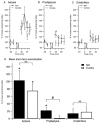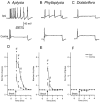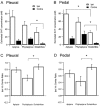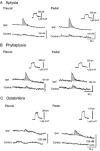Evolution of learning in three aplysiid species: differences in heterosynaptic plasticity contrast with conservation in serotonergic pathways
- PMID: 12740422
- PMCID: PMC2343019
- DOI: 10.1113/jphysiol.2003.038356
Evolution of learning in three aplysiid species: differences in heterosynaptic plasticity contrast with conservation in serotonergic pathways
Abstract
We investigated the neurobiological basis of variation in sensitization between three aplysiid species: Aplysia californica, Phyllaplysia taylori and Dolabrifera dolabrifera. We tested two different forms of sensitization induced by a noxious tail shock: local sensitization, expressed near the site of shock, and general sensitization, tested at remote sites. Aplysia showed both local and general sensitization, whereas Phyllaplysia demonstrated only local sensitization, and Dolabrifera lacked both forms of learning. We then investigated a neurobiological correlate of sensitization, heterosynaptic modulation of sensory neuron excitability by tail-nerve stimulation. We found (1) an increase in sensory neuron (SN) excitability after both ipsilateral and contralateral nerve stimulation in Aplysia, (2) a smaller and shorter-lasting increase in Phyllaplysia, and (3) no effect in Dolabrifera. Because sensitization in Aplysia is strongly correlated with serotonergic (5-HT) neuromodulation, we hypothesized that the observed interspecific variation in sensitization and SN neuromodulation might be correlated with variation in the anatomy and/or functional response of the serotonergic system. However, using immunohistochemistry, we found that all three species showed a similar pattern of 5-HT innervation. Furthermore, they also showed comparable 5-HT release evoked by tail-nerve shock, as measured with chronoamperometry. These observations indicate that interspecific variation in learning is correlated with differences in SN heterosynaptic plasticity within a background of evolutionary conservation in the 5-HT neuromodulatory pathway. We thus hypothesize that evolutionary changes in learning phenotype do not involve modifications of the 5-HT pathway per se, but rather, changes in the response of SNs to the activation of this or other neuromodulatory pathways upon noxious stimulation.
Figures







Similar articles
-
Dissociation between sensitization and learning-related neuromodulation in an aplysiid species.J Comp Neurol. 1999 Jun 14;408(4):506-14. doi: 10.1002/(sici)1096-9861(19990614)408:4<506::aid-cne5>3.0.co;2-p. J Comp Neurol. 1999. PMID: 10340501
-
Serotonin release evoked by tail nerve stimulation in the CNS of aplysia: characterization and relationship to heterosynaptic plasticity.J Neurosci. 2002 Mar 15;22(6):2299-312. doi: 10.1523/JNEUROSCI.22-06-02299.2002. J Neurosci. 2002. PMID: 11896169 Free PMC article.
-
Regulation of behavioral and synaptic plasticity by serotonin release within local modulatory fields in the CNS of Aplysia.J Neurosci. 2006 Dec 6;26(49):12682-93. doi: 10.1523/JNEUROSCI.3309-06.2006. J Neurosci. 2006. PMID: 17151271 Free PMC article.
-
Multiple serotonergic mechanisms contributing to sensitization in aplysia: evidence of diverse serotonin receptor subtypes.Learn Mem. 2003 Sep-Oct;10(5):373-86. doi: 10.1101/lm.66103. Learn Mem. 2003. PMID: 14557610 Free PMC article. Review.
-
Postsynaptic regulation of the development and long-term plasticity of Aplysia sensorimotor synapses in cell culture.J Neurobiol. 1994 Jun;25(6):666-93. doi: 10.1002/neu.480250608. J Neurobiol. 1994. PMID: 8071666 Review.
Cited by
-
The Transition to Minimal Consciousness through the Evolution of Associative Learning.Front Psychol. 2016 Dec 22;7:1954. doi: 10.3389/fpsyg.2016.01954. eCollection 2016. Front Psychol. 2016. PMID: 28066282 Free PMC article.
-
MALDI mass spectrometric imaging using the stretched sample method to reveal neuropeptide distributions in aplysia nervous tissue.Anal Chem. 2009 Nov 15;81(22):9402-9. doi: 10.1021/ac901820v. Anal Chem. 2009. PMID: 19835365 Free PMC article.
-
Biodiversity Meets Neuroscience: From the Sequencing Ship (Ship-Seq) to Deciphering Parallel Evolution of Neural Systems in Omic's Era.Integr Comp Biol. 2015 Dec;55(6):1005-17. doi: 10.1093/icb/icv084. Epub 2015 Jul 10. Integr Comp Biol. 2015. PMID: 26163680 Free PMC article. Review.
-
Parallel evolution of serotonergic neuromodulation underlies independent evolution of rhythmic motor behavior.J Neurosci. 2013 Feb 6;33(6):2709-17. doi: 10.1523/JNEUROSCI.4196-12.2013. J Neurosci. 2013. PMID: 23392697 Free PMC article.
-
Associative memory in three aplysiids: correlation with heterosynaptic modulation.Learn Mem. 2006 Nov-Dec;13(6):820-6. doi: 10.1101/lm.284006. Learn Mem. 2006. PMID: 17142308 Free PMC article.
References
-
- Abrams TW, Castelluci VF, Camardo JS, Kandel ER, Lloyd PE. Two endogenous neuropeptides modulate the gill and siphon withdrawal reflex in Aplysia by presynaptic facilitation involving cAMP-dependent closure of a serotonin-sensitive potassium channel. Proc Natl Acad Sci U S A. 1984;81:7956–7960. - PMC - PubMed
-
- Baxter D, Byrne J. Serotonergic modulation of two potassium currents in the pleural sensory neurons of Aplysia. J Neurophysiol. 1989;62:665–679. - PubMed
-
- Billy A, Walters E. Modulation of mechanosensory threshold in Aplysia by serotonin, small cardioactive peptide B (SCPB), FMRFamide, acetylcholine and dopamine. Neurosci Lett. 1989;105:200–204. - PubMed
Publication types
MeSH terms
Substances
LinkOut - more resources
Full Text Sources

